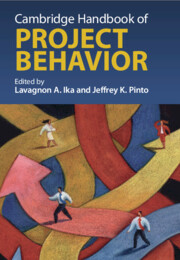Book contents
- Cambridge Handbook of Project Behavior
- Cambridge Handbook of Project Behavior
- Copyright page
- Contents
- Figures
- Tables
- Contributors
- Introduction
- Part I Guiding Principles
- Chapter 1 The Rise and Fall of the Planning Fallacy
- Chapter 2 Unveiling the Hiding Hand
- Chapter 3 Voyages of Discovery
- Chapter 4 Temporal Structuring and Project Behavior
- Chapter 5 Managing Project Complexity and Uncertainty through Dynamic and Systemic Stakeholder Modeling
- Part II Deviating from Plans
- Part III Practical Tips
- Index
- References
Chapter 1 - The Rise and Fall of the Planning Fallacy
From the Impulsion to the Compulsion to Theorize
from Part I - Guiding Principles
Published online by Cambridge University Press: aN Invalid Date NaN
- Cambridge Handbook of Project Behavior
- Cambridge Handbook of Project Behavior
- Copyright page
- Contents
- Figures
- Tables
- Contributors
- Introduction
- Part I Guiding Principles
- Chapter 1 The Rise and Fall of the Planning Fallacy
- Chapter 2 Unveiling the Hiding Hand
- Chapter 3 Voyages of Discovery
- Chapter 4 Temporal Structuring and Project Behavior
- Chapter 5 Managing Project Complexity and Uncertainty through Dynamic and Systemic Stakeholder Modeling
- Part II Deviating from Plans
- Part III Practical Tips
- Index
- References
Summary
The Planning Fallacy principle, a prominent account of project behavior and particularly the causes of cost overruns and benefit shortfalls, stems from the belief that bias outweighs error. Its very popularity begs for an inquiry on its theoretical appeal and whether it remains a viable argument to explain cost overrun and benefit shortfall behavior. This chapter argues that the Planning Fallacy is in danger of danger of being debunked, suggesting that while its rise can be attributed to an impulsion to theorize, its subsequent fall may be due to a companion compulsion to theorize. The chapter focuses on three questions: Is the Planning Fallacy principle a theory anyway and, if yes, is the theory complete? Is the theory too narrow in scope or does it cater to complexity and uncertainty? Will it lose support from the scientific community? The chapter demonstrates that the fall may be due to the incomplete nature of the theory and its limited scope. The chapter contends that the popular appeal of the Planning Fallacy has vastly overstepped its ultimate viability and suggests that the Planning Fallacy principle is itself a form of Planning Fallacy as it overestimates its own theoretical power.
Information
- Type
- Chapter
- Information
- Cambridge Handbook of Project Behavior , pp. 27 - 45Publisher: Cambridge University PressPrint publication year: 2025
References
Accessibility standard: WCAG 2.0 A
Why this information is here
This section outlines the accessibility features of this content - including support for screen readers, full keyboard navigation and high-contrast display options. This may not be relevant for you.Accessibility Information
Content Navigation
Allows you to navigate directly to chapters, sections, or non‐text items through a linked table of contents, reducing the need for extensive scrolling.
Provides an interactive index, letting you go straight to where a term or subject appears in the text without manual searching.
Reading Order & Textual Equivalents
You will encounter all content (including footnotes, captions, etc.) in a clear, sequential flow, making it easier to follow with assistive tools like screen readers.
You get concise descriptions (for images, charts, or media clips), ensuring you do not miss crucial information when visual or audio elements are not accessible.
You get more than just short alt text: you have comprehensive text equivalents, transcripts, captions, or audio descriptions for substantial non‐text content, which is especially helpful for complex visuals or multimedia.
You can access graphs or charts in a text or tabular format, so you are not excluded if you cannot process visual displays.
Visual Accessibility
You will still understand key ideas or prompts without relying solely on colour, which is especially helpful if you have colour vision deficiencies.
You benefit from high‐contrast text, which improves legibility if you have low vision or if you are reading in less‐than‐ideal lighting conditions.
